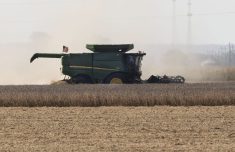By Karl Plume
CHICAGO, Dec 13 (Reuters) – Corn has long reigned as king of the crops in the United States, but soybeans will close the gap in 2017 to one of the narrowest on record as Chinese demand and low grain prices prompt farmers to plant more acres of the oilseed.
American farmers, facing their lowest income in seven years, are rushing to buy soybeans to plant next spring as demand from China has supported prices. Corn, meanwhile, languishes around US$3.50 per bushel – its lowest level in December since 2008.
Read Also

U.S. livestock: Feeder cattle hit contract highs on tight supply
Chicago | Reuters – All Chicago Mercantile Exchange feeder cattle futures and most live cattle futures hit contract highs on…
Corn prices are under pressure because supplies are ample, with the largest U.S. stocks in three decades, along with tough competition on exports from cheaper South American corn and other feed grains.
The switch to soybeans is being closely watched by customers ranging from hog and cattle farmers to food companies as a guage of possibly lower soy prices in the year ahead.
Aaron Sheller, a Noblesville, Indiana, seed producer, said his soybean seed orders are up at least five percent already while corn seed orders have dropped by the same amount.
“The fact that they are already beginning to switch acres is impressive. Normally we don’t see a lot of movement until just before planting in the spring,” he said.
The U.S. Department of Agriculture expects farmers to plant 85.5 million acres of soybeans for 2017, up from 83.7 million a year ago. Farmers are expected to seed 90 million acres of corn, down 4.5 million acres.
Soybeans have only once exceeded corn acres since records began, when severe drought hit the corn belt in 1983. There have only been three other years since 1932 when soybean and corn acres have been closer than the USDA expects in 2017.
Actual soybean plantings may be even higher than the USDA’s initial November outlook, as has been the case in seven of the last 10 years.
A large part of the soybean acreage gains will be around the fringes of the Corn Belt, displacing corn as well as wheat in places like Kansas and North Dakota.
“You’ve got two very powerful incentives for farmers to select soybeans over corn. It’s cheaper to plant soybeans and the board is simply offering more for beans,” said Tanner Ehmke, senior economist with CoBank.
It will cost $233 to plant an acre of soybeans on average land in Indiana next spring, compared with corn planting costs of $418 an acre, according to an analysis by Purdue University economists in October. The net profit on soybeans would be $261 an acre, $50 more than corn, they added, as soybean seeds are cheaper and the crop needs less fertilizer than corn.
Corn prices have eased about 2 percent since then, while soybeans have gained over 3 percent.
A key indicator of better profit potential for soybeans is the new-crop soybean-to-corn futures price ratio, which is currently around 2.6, the highest mid-December level in at least a decade. Levels of 2.4 or 2.5 are considered neutral, favouring neither crop.
A massive rebound in corn production in Brazil and Argentina, which until recently have heavily favoUred soybeans, is also a factor.
Brazil’s corn acreage is poised to bounce back from a severe drought that slashed production in 2016, while Argentine corn seedings are at an all-time high after export taxes were removed.
Combined corn output in the two countries should jump 28 percent for the 2017 harvest from a year earlier, the biggest increase in a quarter of a century, the USDA forecasts.
“That’s probably one thing producers are looking at, saying, we could see an 800-900 million bushel increase in South American corn production. Do we want to expand acreage in the face of that? Probably not,” said Darrel Good, agricultural economist with the University of Illinois.
















